65: Adverts and related documents 1684-1877
Here are a few early advertisements relating to cards from newspapers 1684-1759 and a number of later 19th century documents of interest.
I thought it would be interesting to present some of the early references to playing cards in England. At the Bodleian Library, Oxford there is an online archive of newspapers: 17th and 18th Century Nichols Newspapers Collection, https://tinyurl.galegroup.com/tinyurl/9PygB7. Shelfmark Number: Nich. newsp. 57C; Source Library: Bodleian Libraries; Copyright Statement: © Bodleian Libraries, University of Oxford. There are fascinating descriptions of events from this period and many of the newspapers include advertisements for playing cards and announcements of the ban on imported cards introduced by Charles II and the occasional seizure of contraband cards. Some of the adverts relate to standard packs and others to the non-standard engraved ones such as those by Creake and Lenthall. The later snippets are from another online archive of British periodicals run by ProQuest. This is a large database with 59,893 items on playing cards, although this does include several duplicates and items on card-playing. Consequently, there is too much for just one blog page, so more will follow. I have also added some of the 19th century adverts for cards in the pages on individual makers.
To remind ourselves of the kind of cards that were around at the time, here's a colourful QH.
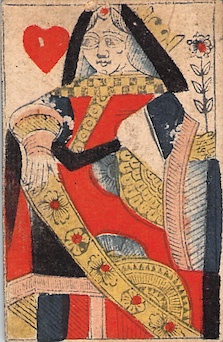
The earliest piece I found was the announcement of the ban on the importation of foreign cards. Because of the nature and size of the downloads I have had to take screenshots of the relevant passages in the text, so that sometimes a single text has had to be broken down into two or three pieces.
1684
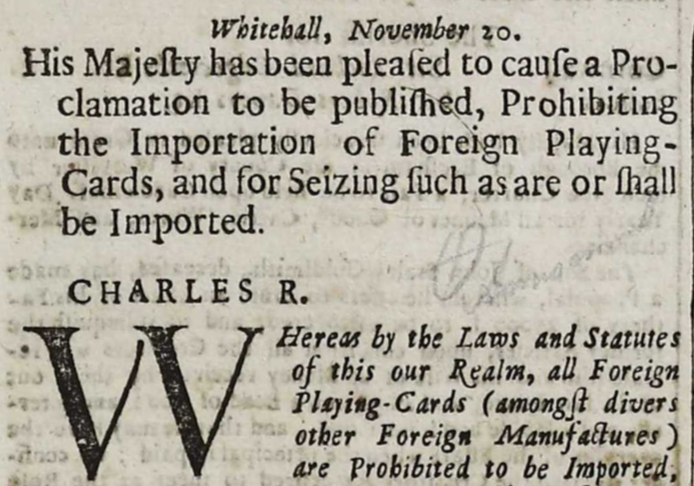
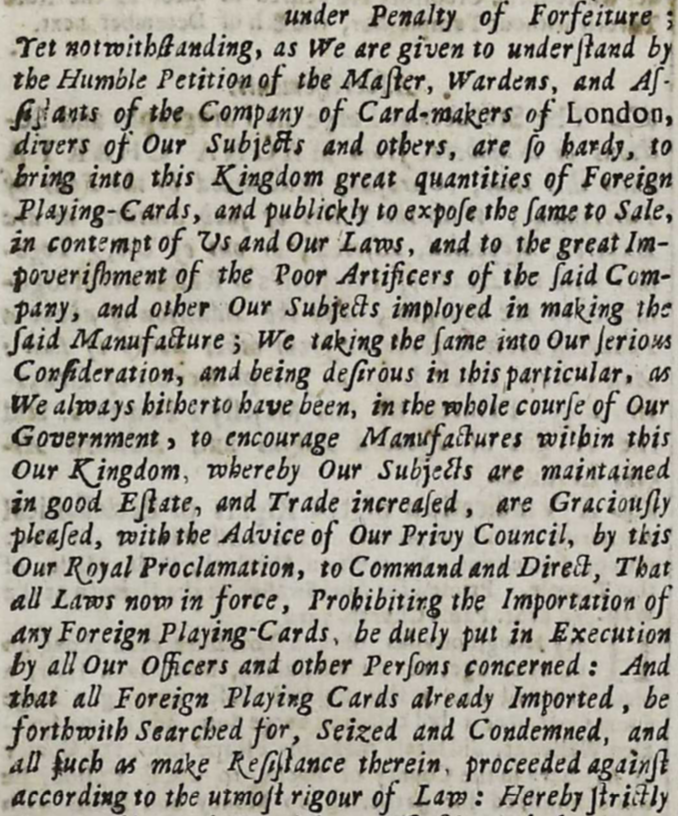

In the same year there is reference to a new office in London for sealing packs of cards.

Another similar notice is reproduced in a magazine of 1821.
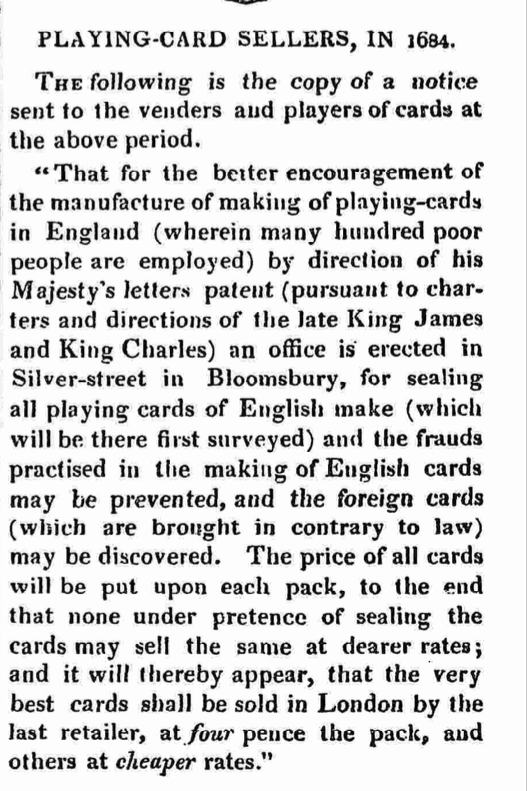
1685
In the next year we find adverts for the cards of the maker Robert Whitfield, who was appointed surveyor at the new Office, both at the Office and at a public sale in a coffee house near the Royal Exchange. The latter advert lists different grades of card and gives the prices per gross. The grades are as follows: mattriss (the cheapest), fine mattriss, fine and superfine (the most expensive). Note that 'superfine' was retained throughout the 18th century and early 19th, presumably to indicate the top quality; it is stamped on the AC.

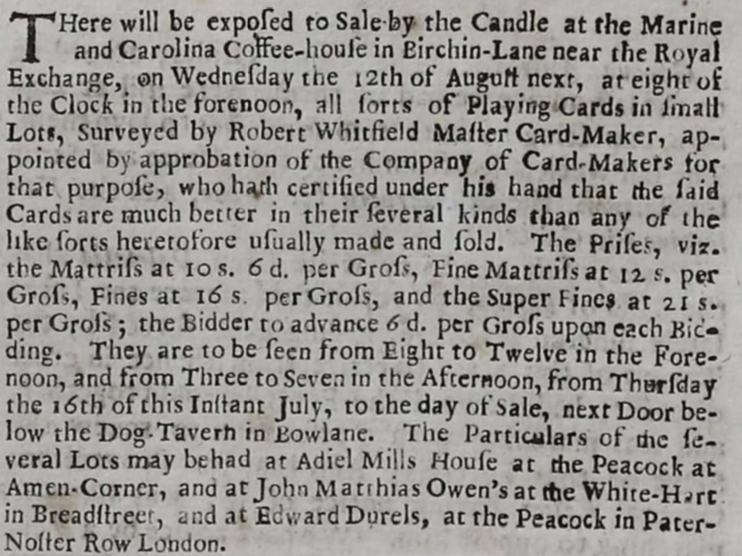
 Hall & Bancks with garter AS (Hall & Son), c.1825
Hall & Bancks with garter AS (Hall & Son), c.1825
1697
The next three adverts are for J. Moxon's engraved cards. The first one suggests that the cards appeared in 1692, unless this is a typographical error, as the newspaper dates from 1697.

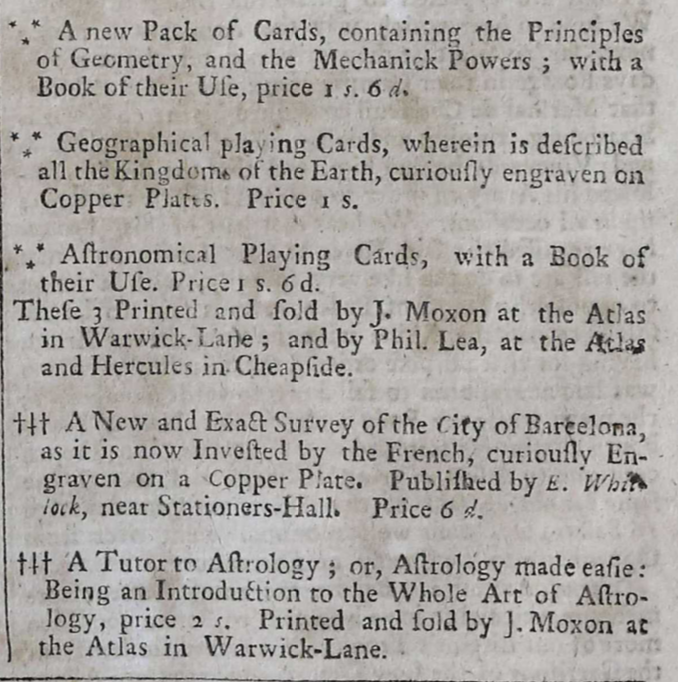
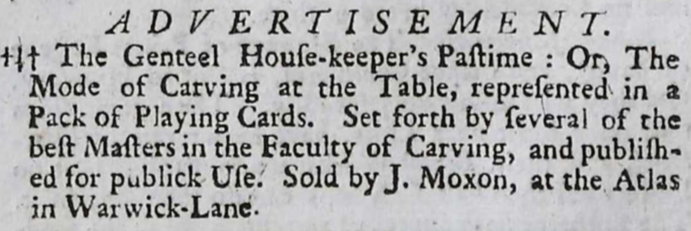
Undated, 1680s
An advert for the Popish Plots pack.

1711
The new tax of 6d (sixpence) per pack was imposed by Queen Anne in 1711/12 and there are a couple of advertisements for the sale of cards at pre-tax prices, before the imposition takes effect. The first is for the cards of Archibald Vans (sometimes Vaus/Voss). Whether some of these are spelling mistakes, or whether he had a French name, which clerks couldn't spell, is not at all clear.


1715
An early advert from just after the imposition of the tax.

1718
One of many lists from John Lenthall, which appear in various years around this time. By 1721 the list contains only 12 packs rather than 21.
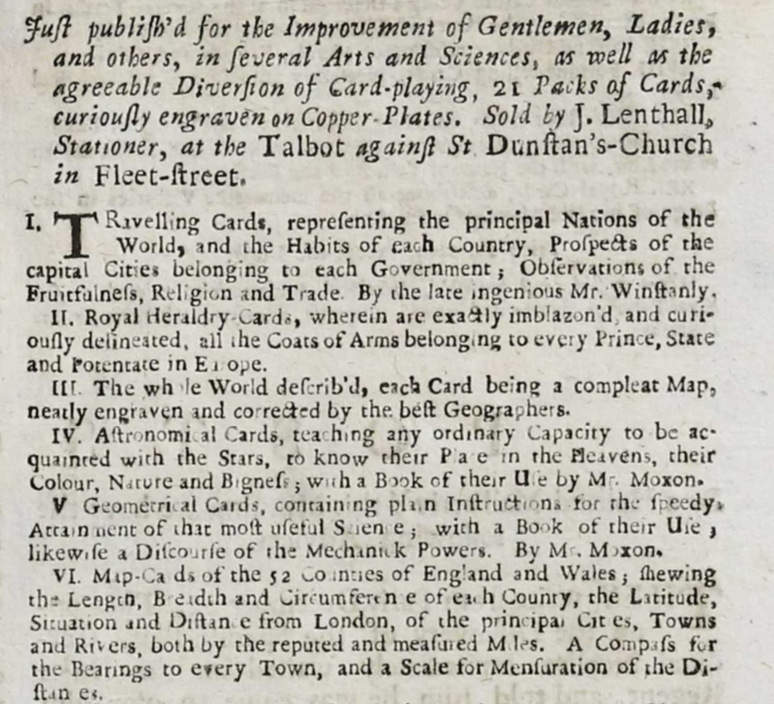

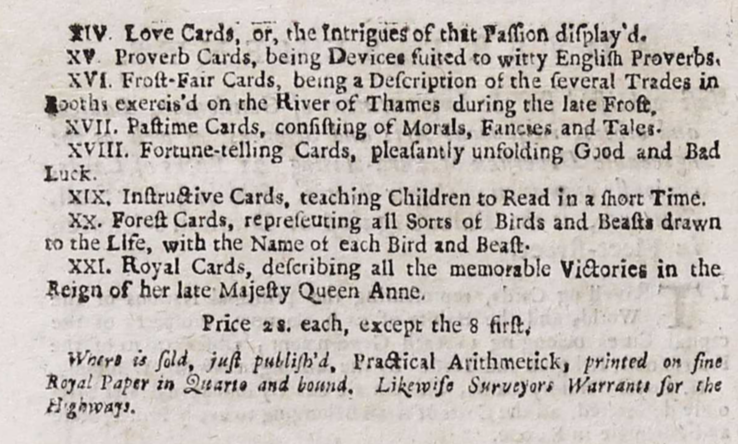
1724
An advert for cards by Edward Warman.

1726
An advert for engraved musical cards by B. Creake, along with an advert for music.
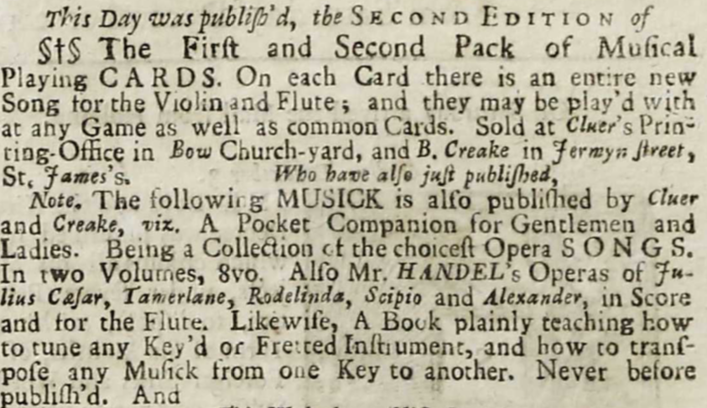
1737
An interesting announcement of the seizure of contraband cards in Scotland.

1759
A political cartoon was published in this year using the court cards to represent rulers and countries. The hearts represent Britain (QH = Britannia). All the courts have been printed the wrong way round. The yellow marks are from the online image, as I have used the search words "playing cards", so each occurrence is highlighted (inaccurately in places!!). I don't know how to get rid of them in this and subsequent texts.
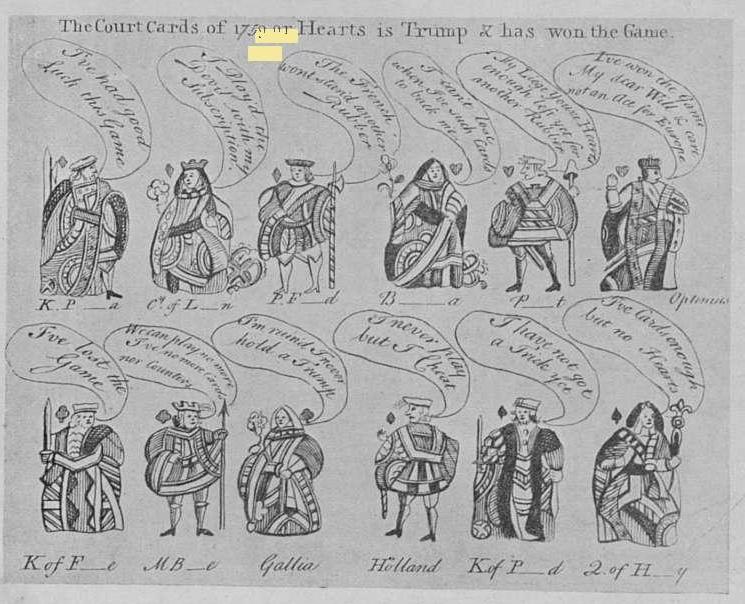
The last two examples from the 18th century come from the British Museum. I'm most grateful to Mike goodall for sending me photocopies of them. Note the reference to piquet (picket) and ombre (quadrille) packs in the Turner advert (1744-50): these had 32 and 40 cards, respectively, the latter having no 8s-10s.

1800
An announcement for the new Ludlow's Knights Cards.

Around the same time there is a wrapper from Thomas Wheeler, the maker of the Ludlow cards, in the British Museum (again thanks to Mike Goodall) on which it clearly states that he was apprenticed to ("from") Gibson. Sadly, the address is difficult to read.
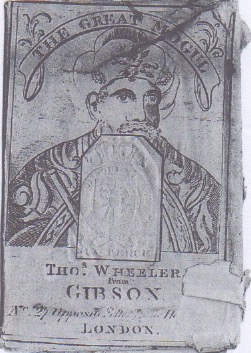
1823
A description of a novel non-standard pack. The first part of the text is rather rambling and is about card-players rather than the new cards. I wonder if they were ever produced.


1830
Here is an account of the case against Henry Wheeler, who was sentenced to transportation in 1838.

In the same year there are advertisements for secondhand cards sold by Mudie's; the first is from June and the second from December. Note the reference to double-headed cards ("antipodes"), which are probably imported from Europe at this time.

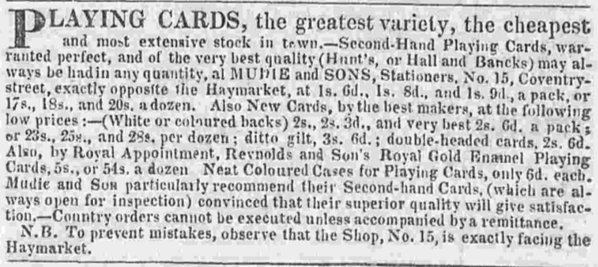
1831
An advert for S & J Fuller's Imperial Royal cards.
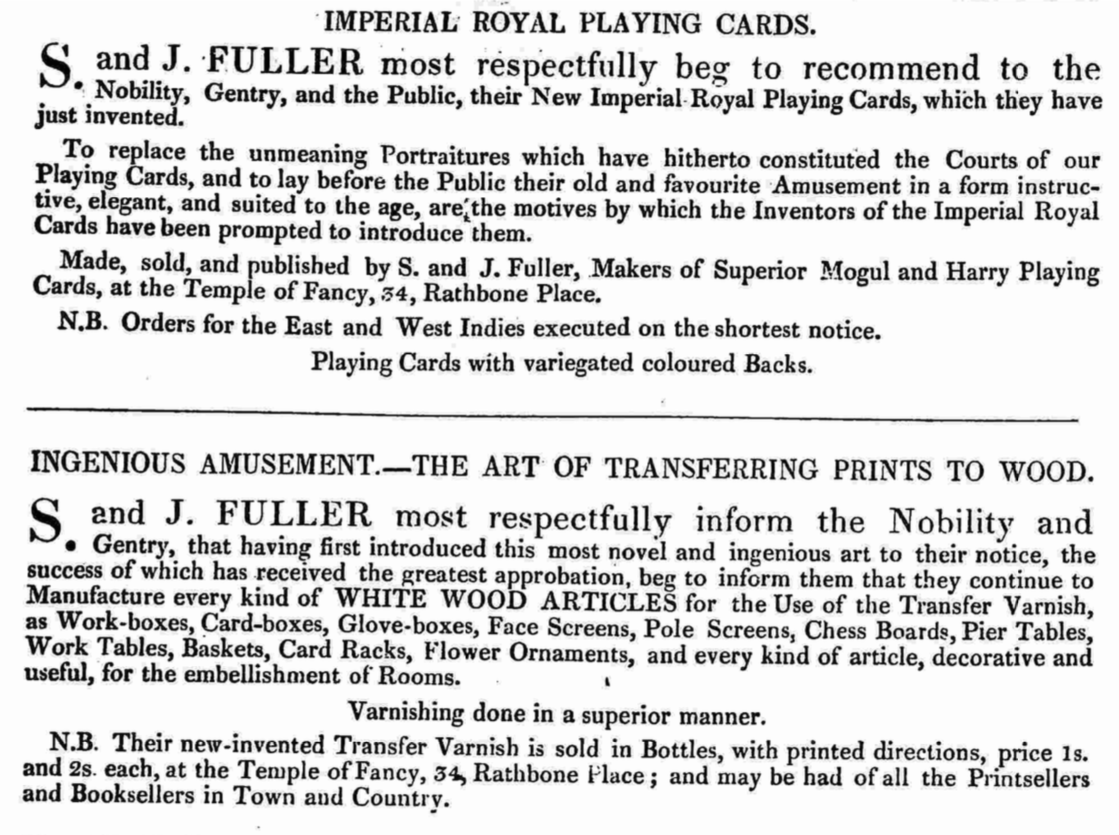
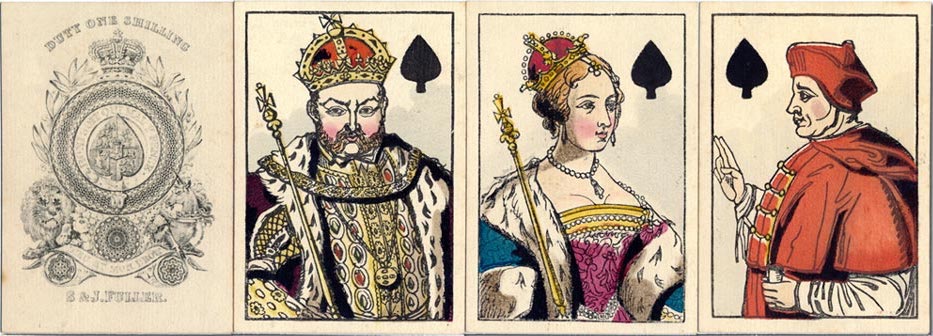
1832
An early De La Rue advertisement, as the firm only started selling cards in that year.
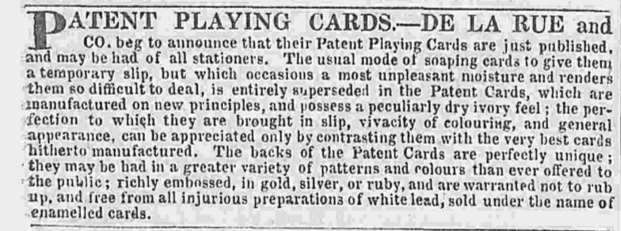
1833
There are few adverts for Reynolds cards around this time: this one has an interesting reference to the design of the backs.

1864
The journal Once a week published a historical survey of the taxation of playing cards in Britain in January 1864 in the wake of the reduction of the tax from one shilling to threepence.


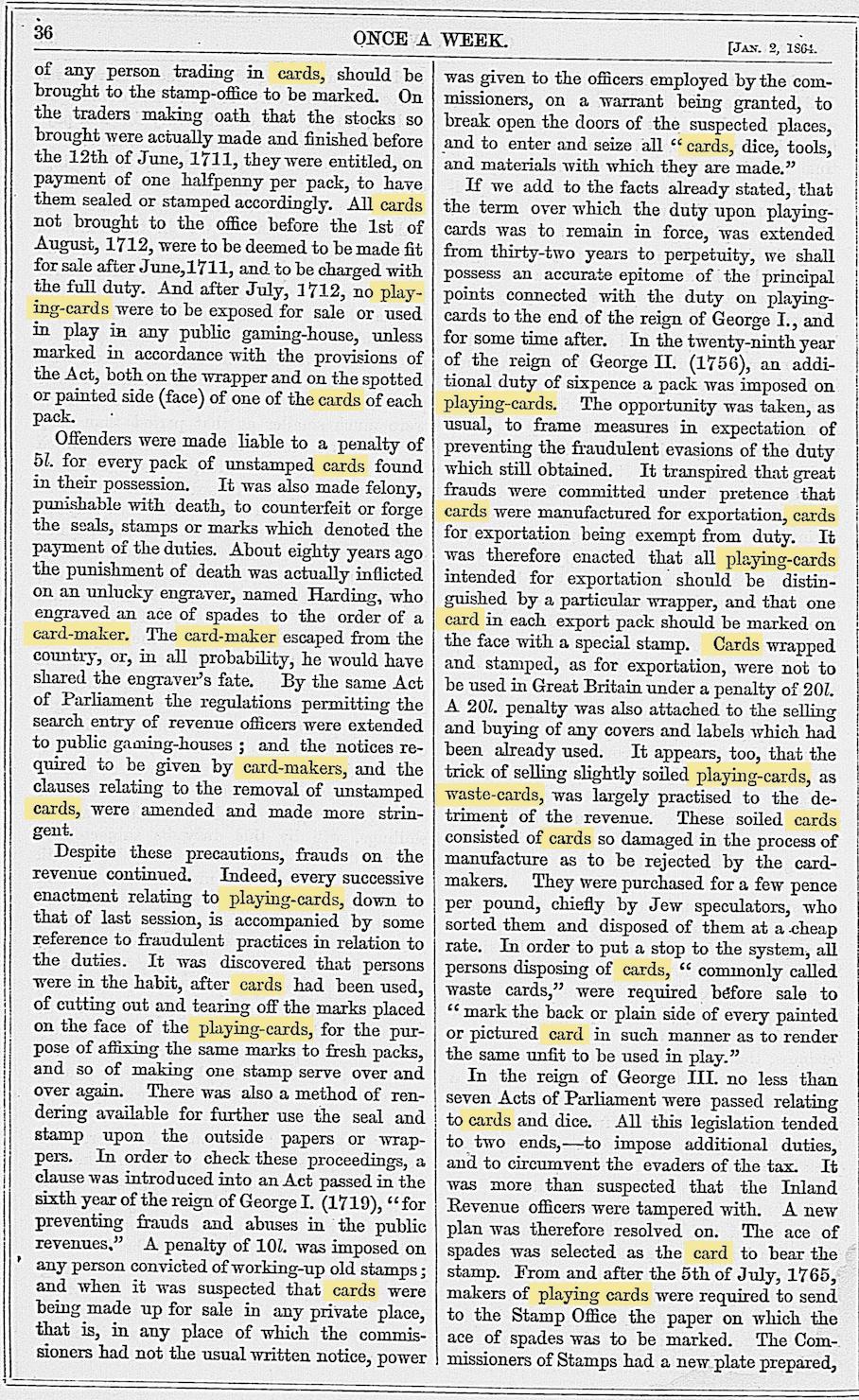
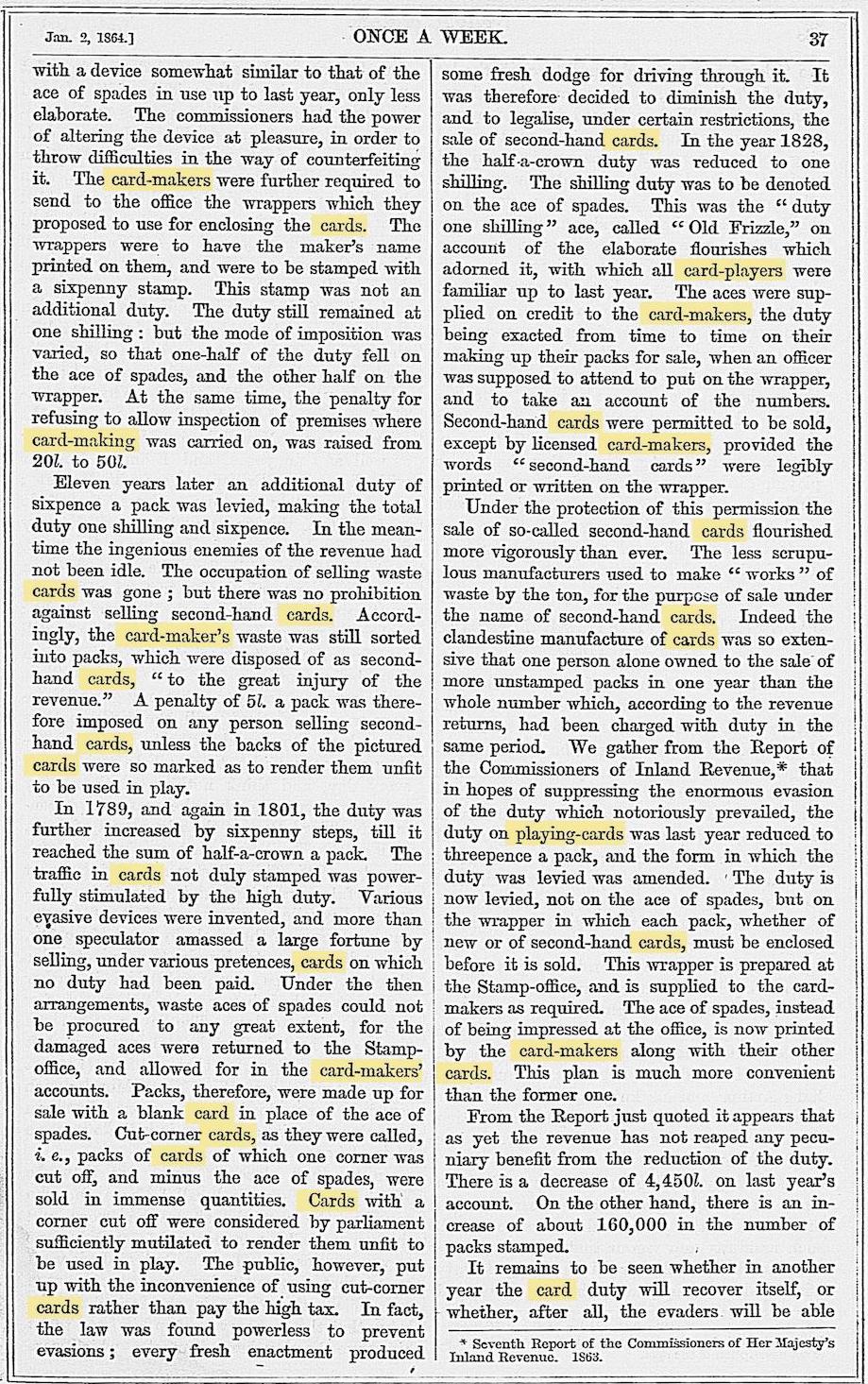

1869
Review of De La Rue playing cards from The Field.


Above: Princess of Wales (223); Indian Jonquil in two colours (207). The Prince of Wales design (158) was introduced earlier, but was perhaps reissued for this particular season. For this and the other two, Fuchsia (219) and Sweet Pea (220), see page 59.
1870
In The Athenaeum a Mr J E Gray suggested that it would be more convenient to have all the pips on the left of the court cards. Whether this was a spur to card-makers to follow this suggestion we don't know, but by 1875 turned courts were the norm. James English had been using turned courts since he started printing cards in 1865.

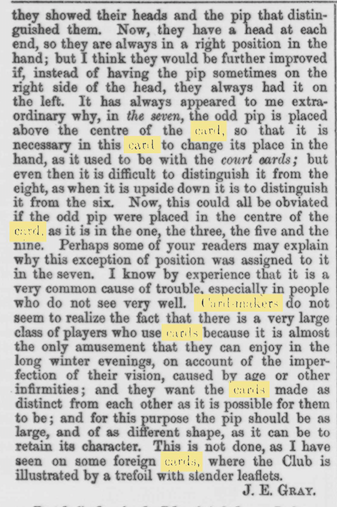

Above: standard James English cards
1872
Review of Grimaud playing cards from The Field.

1877
Review of De La Rue's Dexter playing cards from The Field.
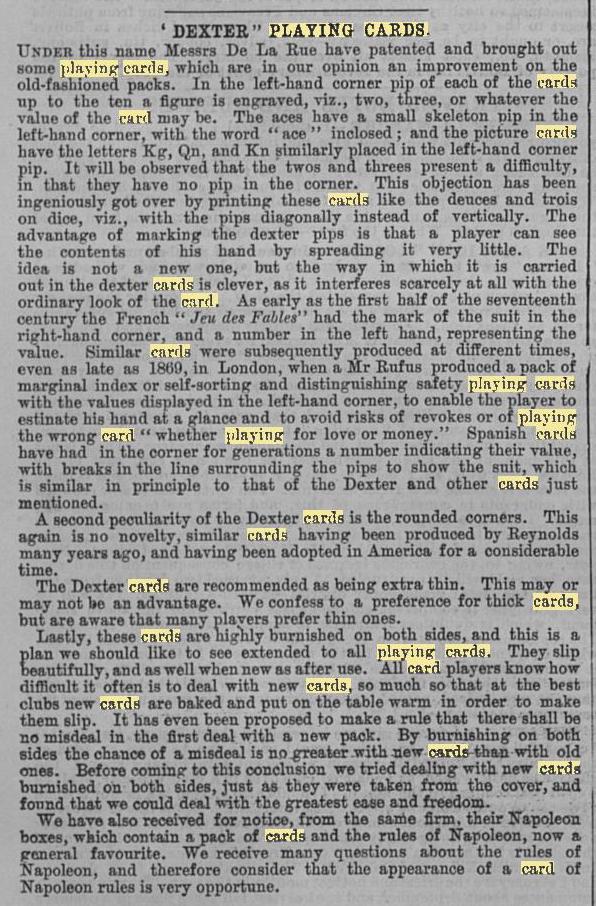
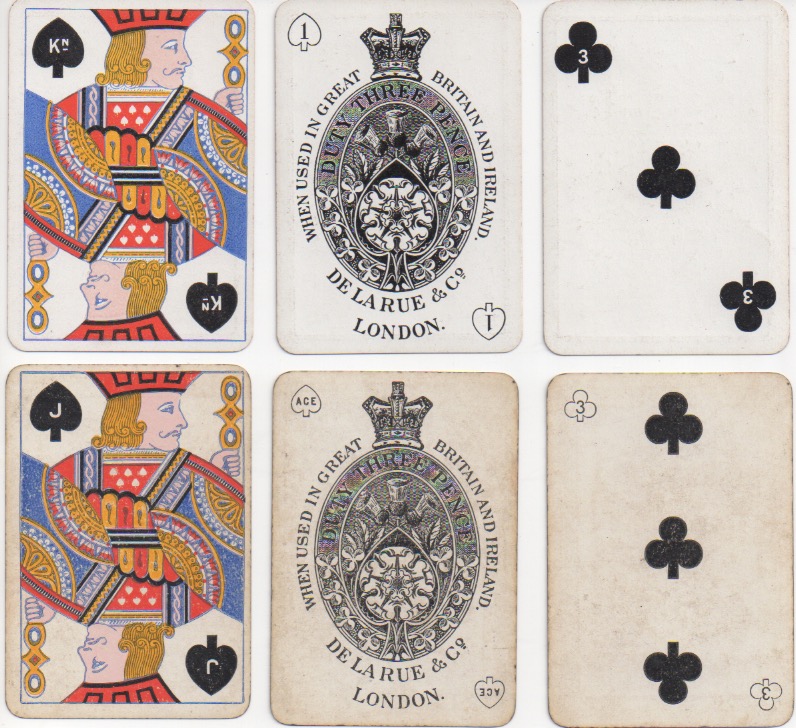
Above: two versions of the Dexter index. Given the description in the text the top one is the original version and the lower a later attempt of improving it. Although the term 'Dexter' was retained for any kind of index, this particular system seems to have been discontinued by the mid-1880s. Queen Victoria's Jubilee pack of 1887 has very small standard indices with the ace being designated by '1'. Dexters of this kind were also used in patience packs into the 1890s.
By Ken Lodge
United Kingdom • Member since May 14, 2012 • Contact
I'm Ken Lodge and have been collecting playing cards since I was about eighteen months old (1945). I am also a trained academic, so I can observe and analyze reasonably well. I've applied these analytical techniques over a long period of time to the study of playing cards and have managed to assemble a large amount of information about them, especially those of the standard English pattern. About Ken Lodge →

Leave a Reply
Your Name
Just nowRelated Articles
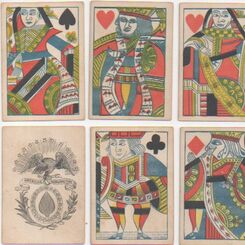
75: Early American cards
An overview of some of the early cards made in the United States.
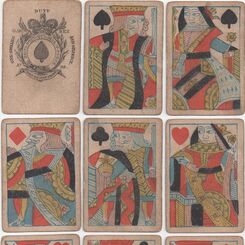
71: Woodblock and stencil: the hearts
A presentation of the main characteristics of the wood-block courts of the heart suit.
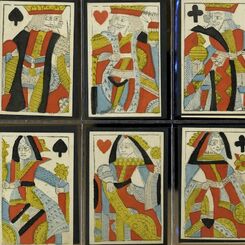
70: Woodblock and stencil : the spade courts
This is a presentation in a more straight forward fashion of the work done by Paul Bostock and me in...

69: My Collection
This is an archive list of my collection. I hope it will be of use and interest to others.

64: The descendants of the French regional patterns: 2
A continuation oF the development of the off-spring of the Paris patterns and a few examples of how ...
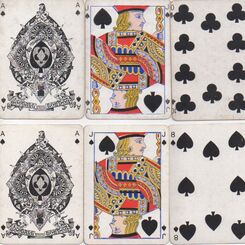
60: Some less common Goodall packs, 1875-95
There are some interesting packs from Goodall in the last quarter of the 19th century.

50: Joseph Reynolds
A presentation of my database of Reynolds cards.

47: Welch’s postcards and De La Rue’s redrawing
There are a number of court card designs that have never actually been produced as cards. It's a sha...
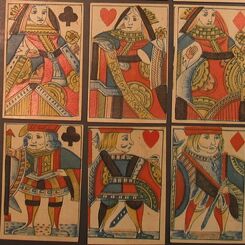
46: Henry Hardy, Henry French & Christopher Groser
A brief look at some makers of whom we know little.

39: Mixed Packs
A number of mixed packs appear for sale from time to time, but it's important to sort out what is me...
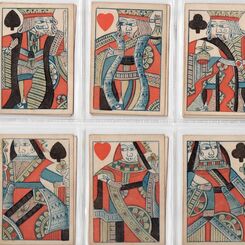
36: Minor Makers of the 19th Century
In 19th century England there were a number of makers who produced cards in relatively small quantit...

35: More Design Copies
Here I want to take another widely copied design and see how individual variation by the copier can ...

29: James English
An overview of the courts and aces of spades produced by James English
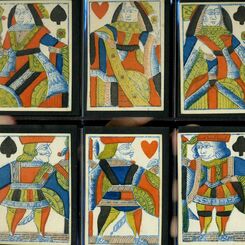
20: English Card-Makers 1761-1905
An initial survey of 19th century playing-card production. More detailed information appears on othe...

19: 19th Century Breaks with Tradition - Unusual versions of the Standard English Pattern
The centuries-long tradition of English court cards was subject to misinterpretation and in some cas...

17: Waddington, Including some of their Less Common Packs
John Berry's two-volume work on the Waddington archive and collection is a very comprehensive presen...

5: De La Rue
In December 1831 Thomas de la Rue was granted his patent for printing playing cards by letterpress.
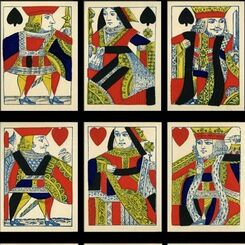
2: Still Collecting Playing Cards at 80
This is a personal account of some of my experiences collecting playing cards.
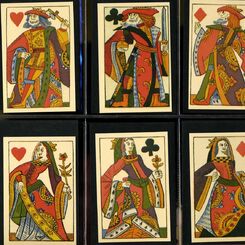
1: Playing Cards and their History: An Introduction and some links to other sites
What was considered the first mention of playing cards in England is in 1463 when Edward I banned th...
Most Popular
Our top articles from the past 60 days


 Your comment here. Your comment here. Your comment here. Your comment here. Your comment here. Your comment here. Your comment here. Your comment here. Your comment here. Your comment here. Your comment here. Your comment here. Your comment here. Your comment here. Your comment here. Your comment here. Your comment here. Your comment here. Your comment here. Your comment here. Your comment here. Your comment here. Your comment here. Your comment here. Your comment here. Your comment here. Your comment here. Your comment here. Your comment here. Your comment here. Your comment here. Your comment here.
Your comment here. Your comment here. Your comment here. Your comment here. Your comment here. Your comment here. Your comment here. Your comment here. Your comment here. Your comment here. Your comment here. Your comment here. Your comment here. Your comment here. Your comment here. Your comment here. Your comment here. Your comment here. Your comment here. Your comment here. Your comment here. Your comment here. Your comment here. Your comment here. Your comment here. Your comment here. Your comment here. Your comment here. Your comment here. Your comment here. Your comment here. Your comment here.





















